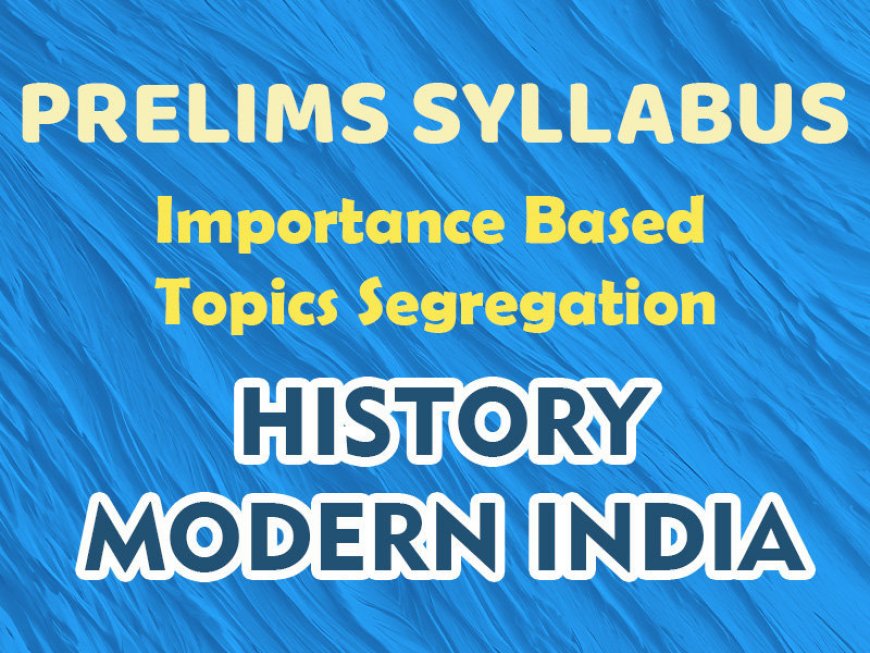Pre - Syllabus - Importance Based - History-Modern India
Pre - Syllabus - Importance Based - History-Modern India

Arrival of European Powers in India (7-9)
· Portuguese (1-3)
o Vasco da Gama's arrival
o Alfonso de Albuquerque
· Dutch and Danes (1-3)
o Trading posts
· British and French (5-7)
o Establishment of factories
o Anglo-French rivalry
British Expansion in India (13-15)
· Battle of Plassey (1757) and Battle of Buxar (1764) (7-9)
o Causes and consequences
o Robert Clive and Mir Jafar
· Subsidiary Alliance and Doctrine of Lapse (5-7)
o Lord Wellesley's policies
o Annexation of Indian states
· Anglo-Mysore and Anglo-Maratha Wars (5-7)
o Tipu Sultan and the Marathas
o Treaties and outcomes
Administrative Policies of British (9-11)
· Regulating Act of 1773 and Pitt's India Act (3-5)
· Permanent Settlement, Ryotwari, and Mahalwari Systems (5-7)
o Land revenue policies
· Judicial and Civil Service Reforms (3-5)
o Establishment of civil services
19th Century Reform Movements (13-15)
· Brahmo Samaj (Raja Ram Mohan Roy) (5-7)
o Abolition of Sati
o Promotion of widow remarriage
· Arya Samaj (Swami Dayananda Saraswati) (5-7)
o Vedic teachings
o Shuddhi Movement
· Prarthana Samaj and Young Bengal Movement (3-5)
o Social reforms
Muslim Reform Movements (5-7)
· Aligarh Movement (Sir Syed Ahmed Khan) (3-5)
o Modern education
· Deoband Movement (1-3)
o Religious education
Other Reform Movements (5-7)
- Theosophical Society (Annie Besant) (3-5)
- Ramakrishna Mission (Swami Vivekananda) (3-5)
Causes of the Revolt (7-9)
· Political Causes (3-5)
o Annexation policies
· Economic Causes (3-5)
o Exploitation and taxation
· Social and Religious Causes (3-5)
o Reforms interfering with traditions
· Military Causes (5-7)
o Discontent among sepoys
o Introduction of Enfield rifle
Course of the Revolt (7-9)
· Main Centers and Leaders (5-7)
o Delhi (Bahadur Shah II)
o Kanpur (Nana Sahib)
o Lucknow (Begum Hazrat Mahal)
· Suppression and Failure (5-7)
o British response
o Reasons for failure
Consequences of the Revolt (5-7)
· End of Company Rule (3-5)
o Government of India Act 1858
· Reorganization of the Army (1-3)
· Changes in Policies (3-5)
o Queen Victoria's Proclamation
Moderate Phase (1885-1905) (13-15)
· Formation of Indian National Congress (INC) (5-7)
o A.O. Hume's role
· Key Leaders and Demands (7-9)
o Dadabhai Naoroji, Gopal Krishna Gokhale
o Economic critique of British rule
· Methods of Moderates (5-7)
o Petitions and resolutions
Extremist Phase (1905-1919) (17-19)
· Partition of Bengal (1905) (7-9)
o Reasons and impact
· Swadeshi and Boycott Movements (9-11)
o Promotion of indigenous goods
· Leaders of Extremists (7-9)
o Bal Gangadhar Tilak, Bipin Chandra Pal, Lala Lajpat Rai
· Revolutionary Activities (5-7)
o Anushilan Samiti, Ghadar Party
Gandhian Era (1919-1947) (20+)
· Rowlatt Act and Jallianwala Bagh Massacre (7-9)
· Non-Cooperation Movement (1920-1922) (9-11)
· Civil Disobedience Movement (1930-1934) (11-13)
· Quit India Movement (1942) (9-11)
· Subhas Chandra Bose and INA (7-9)
Constitutional Developments (13-15)
· Government of India Acts (1919, 1935) (7-9)
o Dyarchy and provincial autonomy
· Simon Commission and Nehru Report (5-7)
· Round Table Conferences (3-5)
Independence and Partition of India (13-15)
· Cripps Mission (1942) (3-5)
· Cabinet Mission Plan (1946) (5-7)
· Mountbatten Plan (1947) (5-7)
· Indian Independence Act (1947) (5-7)
o Partition and its consequences
- Santhal Rebellion (1855-56) (1-3)
- Munda Uprising (1-3)
- Indigo Revolt (1-3)
- Tebhaga Movement (1-3)
· Vernacular Press Act (1878) (1-3)
· Role of Newspapers (1-3)
o Amrit Bazar Patrika, Kesari
· Wood's Dispatch (1854) (1-3)
· Hunter Commission (1-3)
- Ahmadiyya Movement (1-3)
- Singh Sabha Movement (1-3)
- Drain of Wealth Theory (Dadabhai Naoroji) (1-3)
- Deindustrialization of Indian Economy (1-3)
- Railway Development (1-3)
- Policy Towards Princely States (1-3)
- Instruments of Accession (1-3)
ü Role of Women in Freedom Struggle (1-3)
o Sarojini Naidu, Annie Besant
ü Cultural Revival (1-3)
o Bengal Renaissance
ü Legal and Constitutional Reforms (1-3)
o Indian Councils Act
